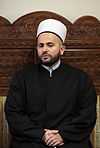Bosniaks of Serbia
| |||||||||||||
| Total population | |||||||||||||
|---|---|---|---|---|---|---|---|---|---|---|---|---|---|
| 145,278 (2011)[1] | |||||||||||||
| Regions with significant populations | |||||||||||||
| Sandžak | |||||||||||||
| Languages | |||||||||||||
| Bosnian, Serbian | |||||||||||||
| Religion | |||||||||||||
| Islam | |||||||||||||
| Related ethnic groups | |||||||||||||
| Other South Slavs. | |||||||||||||
Bosniaks are the fourth largest ethnic group in Serbia after Serbs, Hungarians and Roma, numbering 145,278 or 2.02% of the population according to the 2011 census.[2] They are concentrated in south-western Serbia, and their cultural centre is Novi Pazar.
Demographics
| Part of a series of articles on
|
| Bosniaks
|
|---|
.svg.png) |
|
Recognized |
|
Diaspora Europe Austria · United Kingdom Germany · Sweden Switzerland · Slovenia Czech Republic · Slovakia Kosovo · Turkey North America Australia · New Zealand |
|
Kinship · Architecture · Cultural Heritage Sites · Literature · Music (Sevdalinka) · Art · Cinema Cuisine · Sport |
|
History History of Bosniaks Rulers |
|
|
|
|
Bosniaks primarily live in south-western Serbia, in the region historically known as Sandžak, which is today divided between the states of Serbia and Montenegro. Colloquially referred to as Sandžaklije by themselves and others, Bosniaks form the majority in three out of six municipalities in the Serbian part of Sandžak: Novi Pazar (77.1%), Tutin (90%) and Sjenica (73.8%) and comprise an overall majority of 59.6%. The town of Novi Pazar is a cultural center of the Bosniaks in Serbia. Many Bosniaks from the Sandžak area left after the fall of the Ottoman Empire to continental Turkey. Over the years a large number of Bosniaks from the Sandžak region left to other countries, such as Bosnia and Herzegovina, Turkey, Germany, Sweden, United States, Canada, Australia etc.
Today, the majority of Bosniaks are predominately Sunni Muslim and adhere to the Hanafi school of thought, or law, the largest and oldest school of Islamic law in jurisprudence within Sunni Islam. Some of these Bosniaks are Albanian speaking and live in villages (Boroštica, Doliće, Ugao) located in the Pešter region. They have adopted a Bosniak identity in censuses, due to past sociopolitical discrimination of Albanians in the former Yugoslavia after World War Two.[3]
History

Two thirds of Sandžak Bosniaks trace their ancestry to the regions of Montenegro proper, which they started departing first in 1687, after Turkey lost Boka Kotorska. The trend continued in Old Montenegro after 1711 with the extermination of alleged converts to Islam (“istraga poturica”). Another contributing factor that spurred migration to Sandžak from the Old Montenegro was the fact that the old Orthodox population of Sandžak moved towards Serbia and Habsburg Monarchy (Vojvodina) in two waves, first after 1687, and then, after 1740, basically leaving Sandžak depopulated. The advance of increasingly stronger ethnic Serbs of Montenegro caused additional resettlements out of Montenegro proper in 1858 and 1878, when, upon Treaty of Berlin, Montenegro was recognized as an independent state. While only 20 Bosniak families remained in Nikšić after 1878, the towns like Kolašin, Spuž, Grahovo, and others, completely lost their Bosniak population.
The last segment of Sandžak Bosniaks arrived from a couple of other places. Some Bosniaks came from Slavonia after 1687, when Turkey lost all the lands north of Sava in the Austro-Turkish war. Many more came from Herzegovina in the post-1876 period, after the Herzegovina Rebellion staged by the Serbs against Austro-Hungary and their Muslim subjects. Another wave followed immediately thereafter from both Bosnia and Herzegovina, as the Treaty of Berlin placed the Vilayet of Bosnia under the effective control of Austria-Hungary in 1878. The last wave from Bosnia followed in 1908, when Austria-Hungary officially annexed Bosnia, thereby cutting off all direct ties of Bosnian Muslims to the Sublime Porte, their effective protector.
Politics
In the Sandžak region two main parties that represents the Bosniak population are Party of Democratic Action of Sandžak led by Sulejman Ugljanin and Sandžak Democratic Party led by Rasim Ljajić. Other parties that represents the Bosniak population include Social Liberal Party of Sandžak led by Bajram Omeragić, and Bosniak Democratic Party of Sandžak of Esad Džudžo.
See also
References
- ↑ Census 2011
- ↑
- ↑ Andrea Pieroni, Maria Elena Giusti, & Cassandra L. Quave (2011). "Cross-cultural ethnobiology in the Western Balkans: medical ethnobotany and ethnozoology among Albanians and Serbs in the Pešter Plateau, Sandžak, South-Western Serbia." Human Ecology. 39.(3): 335. "The current population of the Albanian villages is partly “bosniakicised”, since in the last two generations a number of Albanian males began to intermarry with (Muslim) Bosniak women of Pešter. This is one of the reasons why locals in Ugao were declared to be “Bosniaks” in the last census of 2002, or, in Boroštica, to be simply “Muslims”, and in both cases abandoning the previous ethnic label of “Albanians”, which these villages used in the census conducted during “Yugoslavian” times. A number of our informants confirmed that the self-attribution “Albanian” was purposely abandoned in order to avoid problems following the Yugoslav Wars and associated violent incursions of Serbian para-military forces in the area. The oldest generation of the villagers however are still fluent in a dialect of Ghegh Albanian, which appears to have been neglected by European linguists thus far. Additionally, the presence of an Albanian minority in this area has never been brought to the attention of international stakeholders by either the former Yugoslav or the current Serbian authorities."
External links
| ||||||||||||||||||||
| |||||||||||||






.jpg)


